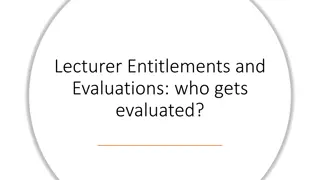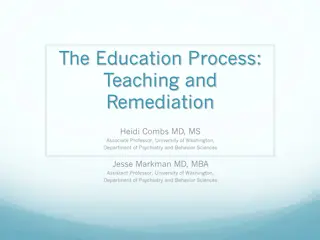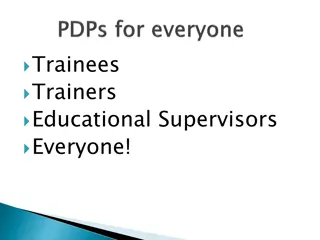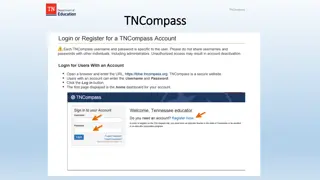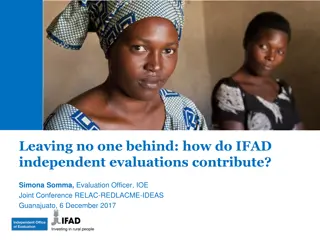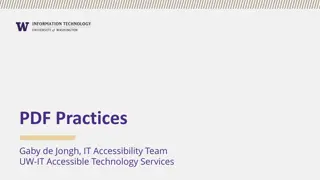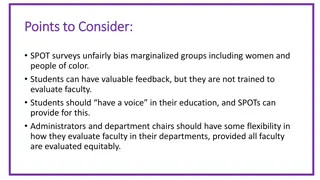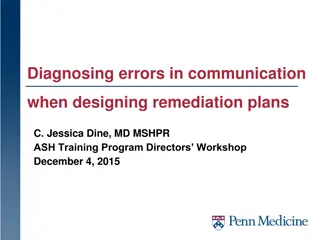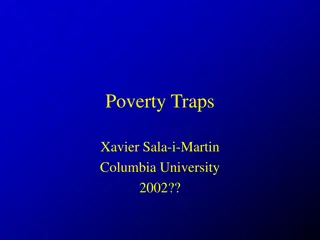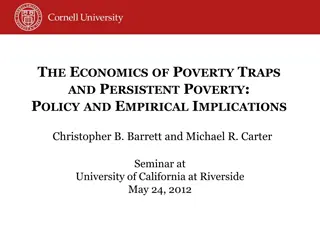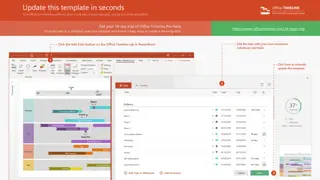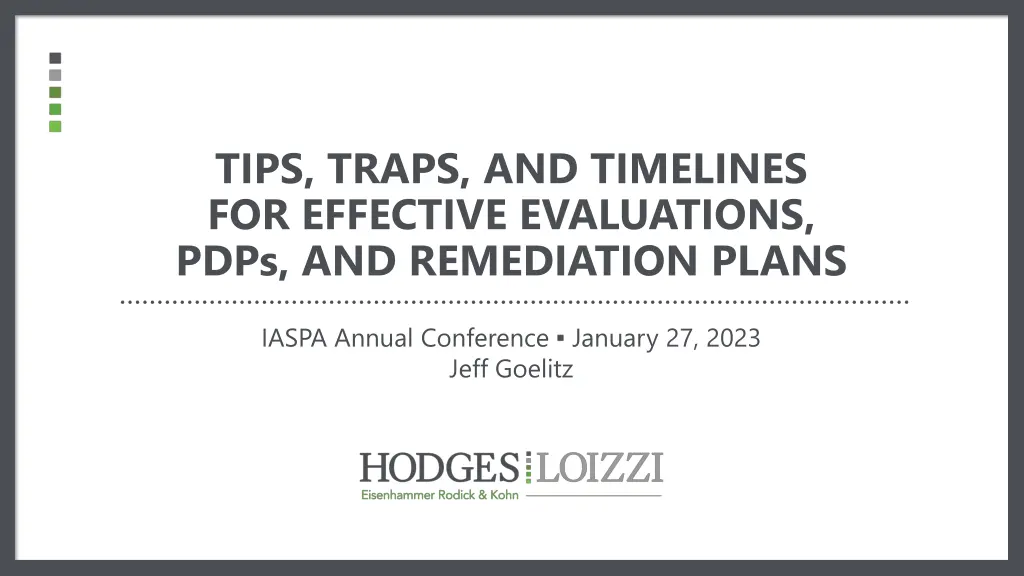
Effective Evaluation Strategies for Professional Development and Remediation
Discover expert tips, common traps, and essential timelines for conducting effective evaluations, creating Personal Development Plans (PDPs), and designing remediation plans. Gain insights into statutory basics, guidelines from the ISBE regulations, and the importance of following legal requirements and district policies. Prepare for the IASPA Annual Conference happening on January 27, 2023, with valuable information shared by Jeff Goelitz.
Download Presentation

Please find below an Image/Link to download the presentation.
The content on the website is provided AS IS for your information and personal use only. It may not be sold, licensed, or shared on other websites without obtaining consent from the author. If you encounter any issues during the download, it is possible that the publisher has removed the file from their server.
You are allowed to download the files provided on this website for personal or commercial use, subject to the condition that they are used lawfully. All files are the property of their respective owners.
The content on the website is provided AS IS for your information and personal use only. It may not be sold, licensed, or shared on other websites without obtaining consent from the author.
E N D
Presentation Transcript
TIPS, TRAPS, AND TIMELINES FOR EFFECTIVE EVALUATIONS, PDPs, AND REMEDIATION PLANS IASPA Annual Conference January 27, 2023 Jeff Goelitz
KNOW, UNDERSTAND, AND FOLLOW Law (i.e., statute and regulations) Your District s Evaluation Plan Your District s Collective Bargaining Agreement Your District s evaluator expectations and norms
STATUTORY BASICS Article 24A sets forth the requirements for evaluating teachers: 1. Personal observation of the teacher in the classroom, unless the teacher has no classroom duties; 2. Consideration of the teacher s attendance, planning, instructional methods, classroom management, where relevant, and competency in the subject matter taught;
STATUTORY BASICS 3. Consideration of student growth as a significant factor; 4. A rating of Excellent, Proficient, Needs Improvement, or Unsatisfactory; 5. Specification as to the teacher s strengths and weaknesses, with supporting reasons for the comments made; 6. Inclusion of a copy of the evaluation in the teacher s personnel file and provision of a copy to the teacher.
NOTIFICATION BEFORE SCHOOL YEAR At the start of every school year (i.e., the first day students are required to be in attendance), the district must notify (either electronically or by paper) each teacher for whom a performance evaluation will be conducted during the school term (If the teacher is hired after the start of the school year, the notice must be provided within 30 days after the teacher s contract is executed)
NOTIFICATION BEFORE SCHOOL YEAR The notice must include: copy of the rubric and other tools to be used to determine a performance evaluation rating; summary of the way in which the student growth and professional practice components will be used to determine a rating; and summary of the district s [Professional Development Plan and Remediation Plan] procedures, to include evaluation tools to be used during the remediation process
# OF OBSERVATIONS Tenured + E or P on last evaluation = 2 observations on next cycle (at least 1 of which must be formal) Tenured + NI or U on last evaluation = 3 observations in next school year (at least 2 of which must be formal) Non-tenured = 3 observations each school year (at least 2 of which must be formal)
FORMAL OBSERVATION REQUIREMENTS Evidence of professional practice must be collected through multiple formal and informal observations. A formal observation requires: an observation of the teacher in his/her classroom for a minimum of 45 minutes at a time; or an observation during a complete lesson; or an observation during an entire class period
NOTIFY IF HEADING TOWARD AN NI OR U If the qualified evaluator determines that the evidence collected to datemay result in the teacher receiving either a Needs Improvement or Unsatisfactory rating, then he/she must notify the teacher of that determination. The teacher shall work with the qualified evaluator (or others) to identify areas for improvement.
DOCUMENT INFORMALS (& OTHER CONCERNS) Evidence gathered during informal observations may be included in the performance evaluation rating so long as i.e., if, and only if it is documented in writing.
TENURED EVALS EVERY 3 YEARS By 9/1/22, tenured + E or P rating = Evaluate at least once in next three school years Include informal observation at least once in the course of the 2 school years after receipt of the rating 13
AUTOMATIC E AND P RATINGS No eval yet in the District + missed eval = no rating Prior eval in District + missed eval = automatic Proficient, unless Probationary + disaster declaration = written agreement on alternate ratings Tenured + E on prior eval + disaster declaration = automatic Excellent 14
UNSATISFACTORY APPEALS BREAKING IT DOWN Union s Role PERA Jt Cmte s Role Q.E. Panel s Role Bargain the appeals process Bargain the issuance of a replacement rating Agree to panel of qualified evaluators Criteria for successful appeals i.e., whether an Unsatisfactory rating is erroneous Assess Unsatisfactory evaluation rating Decide whether to revoke as erroneous
MULTIPLE ROLES OF EVALUATIONS Help improve job performance; address issues Support/justify probationary non-renewal Prove that discrimination was not a motivator Determine placement on Sequence of Honorable Dismissal List Influence acquisition of tenure for teachers Serve as key evidence for H.O. in performance-based dismissals
PHILOSOPHICAL TENSIONS Helping teacher to improve vs. documenting case for dismissal Being supportive and unbiased vs. being clear, direct, and honest
IDEALLY, EVALUATIONS SHOW A PROGRESSION Concerns in observation (+suggestions and/or support) further concerns in subsequent observation deficiencies in evaluation poor evaluation rating Problem areas: Glowing observation reports poor evaluation rating Good evaluations poor evaluation rating in final probationary year Years of good evaluations sudden Unsatisfactory rating
DISMISSAL OF TEACHER IN LAST PROBATIONARY YEAR Written Notice of Dismissal, which must contain reason(s) More prone to challenges Embarrassment for teacher who must continue to work as a lame duck 4 years of events and changes that the teacher can attribute as the cause of the dismissal (i.e., pregnancy, FMLA leave, union involvement, etc.) Inconsistencies in the evaluation history
WHAT WILL 3RD-PARTY CONSIDER MOST IMPORTANT? Domain 1: Domain 3: Instruction Planning & Preparation Domain 2: Domain 4: Classroom Environment Professional Responsibilities 21
CONSIDER THE AUDIENCE Write with a third party, non-educator in mind Potential audiences, beyond the teacher: Board of Education Hearing officer or Judge EEOC or IDHR Investigator Teacher s Union Representative or Attorney
RE-USING EVALUATION CONTENT FOR MULTIPLE PEOPLE OR MULTIPLE YEARS Ms. Roberts failed to use the SmartBoard in her room for any of her observed lessons. That comment might be okay, if Ms. Roberts taught in a classroom that had a SmartBoard.
RE-USING EVALUATION CONTENT FOR MULTIPLE PEOPLE OR MULTIPLE YEARS Ms. Roberts should continue to review her practices of contacting parents when issues arise. If this same comment has been in her evaluation for 3 years running, and it s still an area of weakness, the evaluation should demonstrate that there is an ongoing problem that the teacher either is refusing to address or is incapable of addressing.
SO POLITE/VAGUE WE DONT EVEN KNOW WHAT YOU MEAN For much of the class, students were engaged in whole-group instruction. Is a judge or Hearing Officer even going to know this is a bad thing?
SO POLITE/VAGUE WE DONT EVEN KNOW WHAT YOU MEAN You might consider reviewing your enforcement of the school s cell phone rules. Try instead: You failed to address in any manner the 3 students who were texting on their cell phones during class. Cell phone use during class is explicitly prohibited in the student handbook, and you participated in a staff in-service 2 weeks ago where this issue was specifically addressed. You are expected to know the rule and consistently enforce it in your classes.
SO PASSIVE WE DONT EVEN KNOW IF THE TEACHER DID ANYTHING WRONG You presented the lesson to the class. As always, it is important to monitor student engagement Try instead: You stood at the podium in front of the class and largely read to the class from your lecture notes for at least 10 minutes straight. You neither noticed nor attempted to re-engage the students who had zoned out during your lecture.
SO PASSIVE WE DONT EVEN KNOW IF THE TEACHER DID ANYTHING WRONG Classroom organization is key Try instead: You failed to organize the room to best facilitate instruction. For example, instead of having supplies neatly grouped at each station, you told the students, Just get up and find what you need.
THE EVIDENCE DUMP 2:26 p.m. T circulates and goes over to D 2:27 p.m. T: remember what is a group? Sometimes it is call a family. Is it a column or a row? 2:27 p.m. T: You are dealing with a group of heavy metal 2:28 p.m. T: If this was . . . where would you put this? 2:28 p.m. T: Remember how do we arrange the periodic table? What is the common number? 2:29 p.m. On top of shelves to the left of door appear to be old books in a box. 2:29 p.m. Ss on the other side are laughing (softly) and appear to be off task 2:30 p.m. Ss get back on task. S who has been off task the whole class is quiet, while his partner gets to work
THE EVIDENCE DUMP A running script of the observation has little value unless it contains additional analysis, synthesis, commentary Running scripts are helpful for evidence collection, but they are not observation reports or evaluations, in and of themselves
JUMPING TO CONCLUSIONS WITH NO EVIDENCE TO BACK IT UP You use sarcasm and rude humor that is inappropriate for the age of your students. Try adding specific detail after the original comment: For example, when one student was frustrated at making a mistake and began to cry, you said to him while making a face like you were crying like a baby, Waaa, waaa, does little Jimmy need a pacifier? (This is also a good self-check for the evaluator. If you can t give specific examples to support your conclusions, it could be that you re reaching the wrong conclusion.)
AREAS FOR GROWTH Some evaluation instruments describe/title weaknesses as areas for growth. It is perfectly acceptable to provide areas for growth, but it should also be clear that they relate to a weakness. Telling a teacher who never submits reports on time to Continue to submit IEP paperwork in a timely manner, doesn t really inform the reader that the teacher is consistently failing to do so. Try instead: 6 of the 8 IEPs for which you are responsible were submitted late. One was overdue by more than a week and caused us to have to reschedule a meeting with the parents. You acknowledged to me that you simply failed to allow enough time. This is an area of growth for you in the future, and you are expected to turn in all IEPs in a timely manner.
EDUCATOR-SPEAK You failed to attend well during the meeting Try instead: You weren t paying attention during the meeting
COPY/PASTING DANIELSON RUBRIC Some districts prefer this, but ideally, don t simply quote from the Danielson rubric without additional commentary. The rubric is just the standard. The evaluation should contain your observation and analysis, which you have applied against the standard.
5-STEP FRAMEWORK FOR WRITTEN NARRATIVE 1. State the deficiency 2. Provide specific factual examples that lead to a conclusion 3. Explain what the teacher should have done differently & whether the issue was addressed previously 4. Explain why it matters (e.g., negative impact on students) 5. Tie the deficiency back to the teaching standard or Danielson component
Continue to work on collaboration with your colleagues. Example 1
On occasion, the way you engage with your colleagues is dismissive instead of collaborative. For example, instead of engaging with your colleagues at the March staff meeting, when asked for your input on the new PBIS goals for your grade-level team, you rolled your eyes and said to them, It seems like you ve got this well in hand without me. When you don t engage with your colleagues during exercises like these, it diminishes the efforts of your colleagues and minimizes your buy-in to the process. If we want PBIS to work with our students, we need all our teachers to be on the same page and enforcing these expectations consistently. Example 1
Your classroom space is disorganized. Example 2
2e. Your classroom space is disorganized. Instead of having materials prepared in advance with a set of materials ready at each learning center, you had students spending as much as 8 minutes locating the necessary materials around your classroom before they could begin the assigned lesson. Having the necessary math manipulatives organized in advance could have alleviated the lost instructional time and minimized the students misbehaviors (i.e., they wouldn t have been pushing each other trying to get to the basket of manipulatives). Example 2
Your management of student behavior is inconsistent. Example 3
Your management of student behavior continues to be a source of concern. Even after we discussed this issue (Component 2d) after your last observation, you continue to be inconsistent in your monitoring and response to student misbehavior. For example, you have a class rule requiring students to raise their hand and wait to be called on instead of blurting out the answer. Yet when I observed your class last Friday, you required certain students to abide by this rule but allowed others to blurt out answers repeatedly. As you continue to grow as a teacher, it is important that you enforce your rules fairly and consistently. Otherwise, students who have to abide by your rule will become frustrated and view you as playing favorites, while the students you let slide will come to see that some rules don t apply to them. This will only exacerbate the poor student behaviors you are trying to address. Example 3
OTHER PRACTICAL TIPS Lay the foundation for the reader. Write in the first person. Allow extra time for negative evaluations. Write more than one draft. Start with the domains of most concern. Spelling, punctuation, and grammar do matter.
FOR TENUREDTEACHERS NI rating Professional Development Plans (PDP) Unsatisfactory rating Remediation Plans (For non-tenured teachers, an NI or Unsatisfactory non-renewal, usually)
[The Evaluation Plan must include] within 30 school days after the completion of an evaluation rating a [tenured] teacher as NI, development by the evaluator, in consultation with the teacher, and taking into account the teacher's on-going professional responsibilities including his or her regular teaching assignments, of a professional development plan directed to the areas that need improvement and any supports that the district will provideto address the areas identified as needing improvement 105 ILCS 5/24A-5
PDP REQUIREMENTS Tenured teachers only Follows NI rating Developed within 30 school days Evaluator develops PDP, in consultation with teacher Takes into account teacher s ongoing professional responsibilities, including his/her regular teaching assignments Directed at areas needing improvement Lists supports the District will provide to address areas needing improvement
PDP STATUTE DOES NOT DICTATE A specific duration A summative or formative rating Observations or evaluations A specific outcome upon a failed PDP



